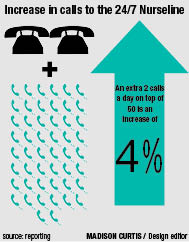A few Ohio State faculty and staff members per day have been calling into a hotline to seek nurses’ advice on whether they have the mumps.
The OSU 24/7 Nurseline, run by HealthFitness, is a service available to faculty and staff who have the OSU Health Plan that allows them to call a registered nurse at any time during the day or night to ask health-related questions.
Representatives from the program have received more calls because of the mumps outbreak, with many calls focused on various questions about mumps, Jane Ferris, the clinical supervisor for the 24/7 Nurseline, said in an email.
In addition to the average 50 calls per day, the line has been receiving an additional one or two calls per day about the outbreak, Ferris said.
As of Friday afternoon, 199 mumps cases had been reported in Franklin and Delaware counties, up 10 from Thursday. Of those cases, 126 of were linked to the OSU outbreak, an increase of six cases from Thursday, according to a Columbus Public Health release.
The onset of the first case connected to the Franklin County outbreak was Jan. 7, while the first case connected to OSU was Feb. 10.
Mumps is a viral infection of the salivary glands, according to the Centers for Disease Control and Prevention website. It can spread through coughing, sneezing or contact with saliva or mucus. According to the CDC website, the disease can be carried without any symptoms.
Those who are affected by mumps might have swollen and tender salivary glands under the ears or jaw on the side of the face, fever, headache, muscle aches, tiredness, loss of appetite and inflammation of the testicles in men, according to the CDC. The website also says there is no specific treatment for mumps, but it is usually gone in a week or two.
Ryan Radebaugh, a program coordinator for global engagement in the Office of International Affairs, said although he has not used the service, he has noticed the increased tension at his workplace whenever someone gets sick since the mumps outbreak.
“People with children, husbands and wives are definitely more concerned — they have families to worry about,” he said. “They don’t want to take that home with them.”
Radebaugh said although he has not used the line, the Nurseline was mentioned to him during his first week of employment three months ago.
“It sounds like a great service,” he said.
There are 11 registered nurses who work for the Nurseline. The cost of the service to OSU is “less than $70,000 annually,” Lorena Owings, director of medical management and customer service for the OSU Health Plan, said in an email.
Ferris said typically the calls to the line fall under three categories:
New illnesses: Most often, callers use the service to ask questions about their symptoms and either scheduling an appointment with a physician or going straight to the emergency room.
Continuing or recent conditions: About 25 to 30 percent of the calls are for health information, such as diagnoses, new prescriptions or advice about the level of care the person should receive for their condition.
Potential illnesses: Callers sometimes ask about what they should be doing before seeing a physician or signs and symptoms to watch for.
Alyson Moses, an OSU communication professor, said she has used a similar program through her pediatrician’s office and said the 24/7 Nurseline seems like a “great resource” for faculty.
“It’s nice to get expert perspective from a health care professional without having to go in for a doctor’s appointment, especially if symptoms are minor,” she said in an email.



